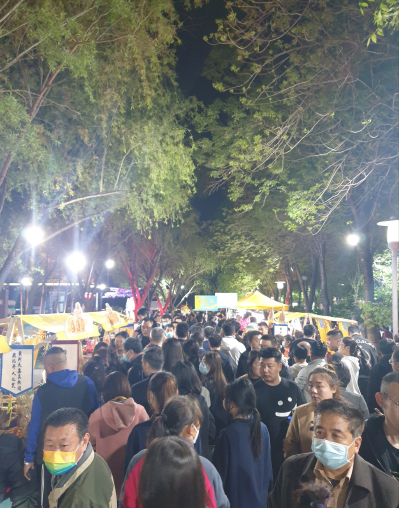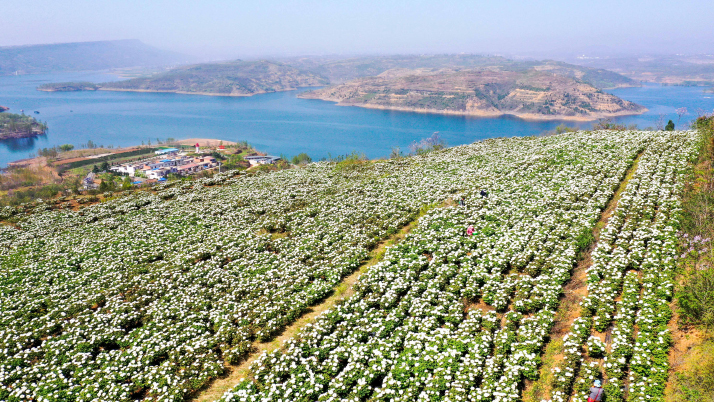| Lifestyle |
| From the cradle of Chinese civilization to contemporary culture | |
|
|
 Droves of visitors crowd the Yellow River Fair in Dongying City, Shandong Province, on April 17 (ELSBETH VAN PARIDON)
The Yellow River, known as the Cradle of Chinese Civilization, is not just a long and winding icon of China, but also a symbol of the Chinese spirit: bearing burdens (its sedimentation), adaptation (its shifting course) and perseverance (its continual flow). The second longest river in China originates at an elevation above 4,600 meters on the Qinghai-Tibet Plateau in Qinghai Province and flows from west to east through eight more provinces and autonomous regions—Sichuan, Gansu, Ningxia, Inner Mongolia, Shaanxi, Shanxi, Henan and Shandong. For thousands of years, the river has been admired by great poets and artists, with their words and melodies telling of the spirit of the Yellow River and Chinese people. For thousands of years, the country's Mother River, the most sediment-laden stream in the world, has been a source of both joy and grief for those residing along her torrent as she has caused her fair share of devastating floods throughout history. And so for thousands of years, Yellow River protection and flood prevention have been a priority in national governance. On the heels of the Yangtze River Protection Law, China's first law governing river basins that took effect on March 1, 2021, came the entry into force of the Yellow River Protection Law in April this year. The law specifies a series of institutional measures, emphasizing that focusing on key areas, implementing major ecological restoration projects, accelerating regional desertification control, increasing the comprehensive control of soil erosion, promoting wetland protection and ecological governance, and building green ecological corridors, will ensure those relying on her stream can bank on her assets for centuries to come. One such asset is cultural tourism. Daka in Dongying Dongying, a city in Shandong Province, where the Yellow River empties into the Bohai Sea, is now utilizing its ecological resources such as wetland bird habitats and other unique river landscapes to transform itself into a tourism destination focusing on Yellow River culture. In 2021, visitors made 16.46 million trips to Dongying, generating tourism revenue of 17.11 billion yuan ($2.54 billion), according to statistics from the city government. It seemed only fitting that on April 18-19, Dongying hosted a two-day forum on the promotion of the Mother River's culture to discuss ways to stream her tales of woe and "whoa!" around the world. Jointly hosted by the Chinese Academy of Social Sciences, the China Public Relations Association and the Shandong Provincial People's Government, the forum, themed Promoting Yellow River Culture and Telling Yellow River Stories, gathered cultural experts, scholars and officials from across the country to discuss the core characteristics of Yellow River culture and their contemporary value, as well as ways to innovate the international communication of the stream's culture. In his forum address on April 18, President of the Academy of Contemporary China and World Studies Yu Yunquan said, "Recent years have seen the Dongying government up its efforts in exploring the cultural meaning held within the Yellow River, developing high-quality cultural tourism projects and organizing a range of cultural tourism activities." One related hot spot in the city, especially after the sun sets, is the Yellow River Fair, an open-air market which normally opens only on the weekend. But in light of the upcoming forum, it opened on weekdays to give attendees a sneak peek of its cultural prowess. On the night of Monday April 17, right before the forum opened, this author saw with her own eyes the droves of visitors at the market, all trying to get a view, a whiff or a bite of the products hailing from the nine provinces and regions through which the Mother River roars and thunders. Vendors at the market gave it their all, both directly to visitors and online via live commerce; performers from areas along the Yellow River, dressed to their local nines and busting a traditional move or two, dotted the market; and light danced on the surrounding water. Summing up, this market constituted a bonafide dakadian—literally "punching card spot." The term daka has become a fixture on Chinese social media in recent years. The expression refers to the trend of people taking short trips to "punch in" at popular places and then posting pictures and other content on social media to show what they got up to. German expert at Beijing-based Foreign Languages Press Burkhard Risse, too, was at the market. He told Beijing Review, "Compared to many indoor venues, the Yellow River Fair has a very special vibe, a sensation that will resonate with both domestic and international visitors." This year alone, Dongying has launched nearly 20 online and offline cultural tourism activities such as cycling along the Yellow River and wetland excursions. As one of the key cities of the Yellow River Delta, it features an abundance of inland and coastal wetlands, river wetlands, lake wetlands, swamps and constructed wetlands. On that note, Risse said, "In Dongying, tourists can enjoy the extraordinary experience of the Yellow River's muddy waters meeting the bright blue of the Bohai Sea; tourists traveling in from abroad, particularly, may also gain more insight into the Chinese concept of green civilization here and see the Yellow River's evolution from a 'disaster river' to a 'stream of good luck'."  The Yellow River, also known as China's Mother River, flows along a peony field in Luoyang, Henan Province, on April 10 (XINHUA)
Branching out As someone who explores China through the lens of fashion and urban culture, this author would like to extend the narrative from protecting the ecological environment of China's Cradle of Civilization to the country's contemporary younger generations and their growing eco-consciousness—i.e., their growing awareness of sustainability, from wardrobes to general lifestyles. Many of China's millennials and, particularly, Gen Zs, consider themselves expert consumers who do their homework before purchasing products. That includes checking whether Mother Nature is getting her fair share of respect. Gen-Z and millennial consumers in China—as well as in India and other emerging economies—are "more environmentally conscious, more likely to buy sustainable products and more distrustful of corporate sustainability claims than their counterparts in developed countries," according to a 2022 Credit Suisse Research Institute report. Sustainable fashion and lifestyles are now a growing wave in China as more and more designers and brands focus on ethical sourcing and durable practices to appease shifting consumer values. Many of these do not necessarily focus on fashion but perhaps offer cups and plates or pillow cases artisanally produced by one of the country's ethnic minorities. Out with fast fashion and fast living, and in with long-lasting, eco-friendly, responsibly produced items. From yak yarn spinning and weaving collectives on the Qinghai-Tibet Plateau teaming up with brands seeking to offer new, exclusive, exotic sustainable apparel to ecologically and ethically conscious consumers, to young designers turning unwanted clothes into the most burning wardrobe desires, strutting down the catwalk of Shanghai Fashion Week (SFW), China is home to a circular and sustainable revolution in motion. And so we branch out to the south, all the way to the Magic City. Inviting speakers, leaders and innovators in the ecopreneurial field, SFW, held in Shanghai twice a year, has since 2015 been upping the sustainability stakes by informing invitees on the ecological fashion emergencies at hand and calling for more thoughtful designer action. Circularity was once again a hot topic during its latest edition (March 23-31), with many millennial and Gen-Z designers implementing sustainable techniques—whether using fabric made from waste-based products or promoting their brand's zero-waste lifestyle vision. By homing in on the topics of eco-consciousness and circularity, on both the industry and consumer ends, SFW is slowly but surely assembling a young innovation community in sustainable fashion, empowering resource interactions and promoting a deep transformation of the fashion industry at large. Post-pandemic global and domestic shifts on issues like climate change and green energy are spurring young Chinese nationwide to reconsider their values and purpose in life. With the millennial and Gen-Z focus shifting from "ego" to "eco" one social media snippet at a time, it seems they have collectively decided to go with the flow—the green flow. (Print Edition Title: Go With the Flow) Copyedited by G.P. Wilson Comments to elsbeth@cicgamericas.com |
|
||||||||||||||||||||||||||||
|